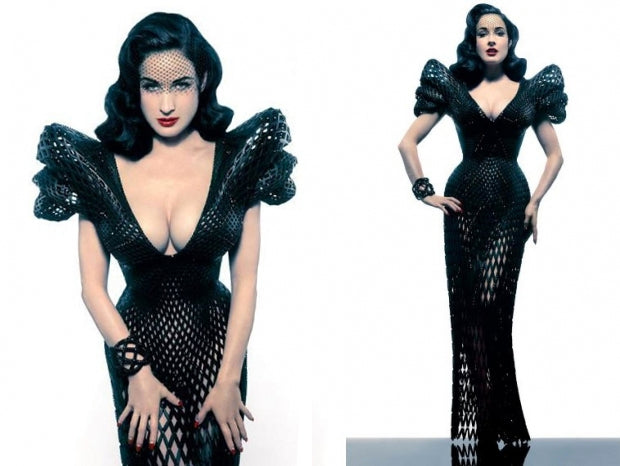The Revolution and Evolution of 3-D Printed Fashion

Ever since the dawn of 3D printing, designers and inventors have been trying to come up with groundbreaking ways to utilize its capabilities. 3D printed fashion is a fairly new concept, with its early use focused on creating stiff, structural garments that did not leave much room for movement. Like in the photo above, the dress on the left side definitely looks pretty, but it would be very uncomfortable to wear, the one in the middle is not stiff and has nice flow, but still it is not made of natural fiber.
With new technology, that has all changed. A whole new world of possibility is opening up for 3D printing and fashion is at the forefront of this movement. Now you can create your own clothing made of natural fiber like the photo at the top right.
I introduce to you Electroloom. This is the world’s first 3D fabric printer and has started quite a buzz with their Kickstarter campaign raising over $80,000 in only one month. Electroloom creates seamless, ready-to-wear garments all from a simple CAD template. No sewing required.

The process consists of a number of nozzles spraying a cotton/polyester blend solution onto a metal or spray painted cardboard template. After 8 to 14 hours you have a seamless garment. The Electroloom team is also experimenting with other textiles such as silk and acrylic, as well as finding ways to incorporate colors into their fabric. With their Kickstarter campaign a massive success, we can’t wait to see what new developments and new technologies come from Electroloom in the future.

Fabric isn’t the only thing revolutionary coming out of 3D printing. The company Feetz is taking a new approach to footwear by creating an entirely 3D printed and customizable shoe. With $1.25M in funding, Feetz has launched it’s own app to tailor make your own 3D shoes. The app lets you take a series of photographs of your feet from different positions and upload them to the Feetz e-commerce platform. You are then able to purchase shoes made perfectly for you.
Feetz is in the process of collecting data from consumers’ foot scans to maximize their accuracy and minimize size issues and offers a $5,000 foot scanner to anyone who intends on using their technology professionally. With fully 3D printed shoes already a reality, the world of custom footwear is quickly being established as a norm.

Lastly, designer Oluwaseyi Sosanya has already been recognized for his innovation in connecting 3D printing with “warp and weft” logic. Sosanya explains his original interest in weaving to The Guardian, “we’ve been using the same sort of weaving techniques for thousands of years. This shirt that I am wearing right now is woven in the same way as a shirt that was made 3,000 years ago,” the designer says.

Using his 3D weaver, he makes three dimensional structures out of everything from cotton to wool. His machine weaves the yarn around sturdy tubes and transforms it into flexible and strong objects. His knowledge of 3D printed shoe soles led to his collaboration with footwear designers Lixian Teng and Tomiwa Adeosun.
His vision is to incorporate this technology into providing protective athletic wear and even bullet proof vests. Sosanya also wants to use his 3D weaving process to create and design buildings in the future.
With the advancement of technology in the 3D printing world, many people see the possibilities in creating innovative and practical fashion. As the opportunities for customization and on-demand products grow in leaps and bounds, it makes us wonder about the effect it will have on consumer behavior. If you can design your own items, would you pick those goods over the ones with a designer’s label on it? Will how we view famous, as well as up-and-coming designers, change when anyone can design clothing? Just as the internet has made everyone a writer, and social media has made everyone a reporter, undoubtedly 3D printing will change how consumers interact with how their clothing is designed.
Regardless of how 3D printing affects the design industry ultimately, it will definitely change the world as we know it. Imagine a future where we can all be creators and makers of not just clothing, but an almost infinite number of goods. From shoe soles to high rises, the capabilities of 3D printing are truly endless!
Look at this 3D printed dress worn by Dita Von Teese, soon you can make your own fancier or less fancier, made of natural fiber!

